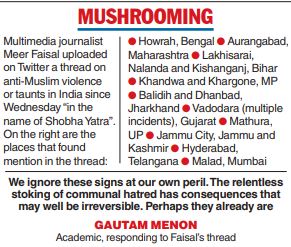During the citizenship law protests in Delhi in December 2019, Prime Minister Narendra Modi had said: “People who are setting fire (to property) can be seen on TV.... They can be identified by the clothes they are wearing.”
On Friday, referring to alleged clashes between two communities in Howrah the previous day, Bengal BJP president Sukanta Majumdar tweeted: “@abhishekaitc. This is enough to expose your lies. You can easily identify the rioters with (sic) their clothes....”
The tweet was later deleted. The reference to “clothes” in the two comments cannot have been coincidental, for the vilification of Muslims has been a key plank of BJP politics in Bengal and the country at large in the past few years.
Bengal witnessed over 2,000 Ram Navami processions on Thursday. A significant majority of them — organised by local wings of Hindutva outfits like the Bajrang Dal and VHP and led by local BJP leaders — featured participants who carried swords and other arms and appeared to use “Jai Shri Ram” as a war cry.
Violence erupted while one such procession, in the Fazirbazar area of Kazipara in Howrah, was passing along GT Road on Thursday evening. The situation remained tense in the area till Friday afternoon.
Chief minister Mamata Banerjee blamed the communal tension in pockets of Howrah on the saffron ecosystem, accusing it of stoking communal violence for political gain through polarisation.
State BJP leaders swatted away the charges, reached out to their national leaders and governor C.V. Ananda Bose, and vowed to expose the Bengal administration’s “appeasement of one particular community”.
A video released by Trinamul shows a man, brandishing what looks like a revolver, dancing with others who are waving saffron flags. Majumdar chose to ignore the video and instead speak about the “clothes” of some people seen in another purported video from Howrah.
Life had returned to normal in Howrah’s affected areas by Friday evening.But with the BJP desperate to keep the pot boiling, the political heat surrounding the violence grew.
Till late Friday evening, the police had arrested over 40 people in connection with the violence.
The exact reason behind the violence too remained hazy. Trinamul accused the marchers of provocation while the BJP blamed an alleged lack of police arrangement, Mamata’s comments and her party’s “posturing”.
Majumdar, in a tweet accompanying a purported video of the violence, accused Mamata of “appeasement of one particular community”.

While on the subject of law and order, Majumdar, like other BJP leaders, left certain questions untouched:
■ Why BJP leaders insist on organising processions in which participants carry a variety of arms.
Ram Navami celebrations over the last few years have seen every senior BJP leader — from former state president Dilip Ghosh to Adhikari — prodding people to hit the streets with arms. Ghosh had even been booked under the Arms Act in 2019.
But such has been the pressure from the saffron lobby that the state administration has not prohibited the carrying of arms at Ram Navami processions.
■ Why the BJP has been so intent on making Ram Navami processions — largely a north Indian tradition — ubiquitous across the length and the breadth of Bengal in recent years.
“This Ram Navami procession is clearly an imported culture.... We are seeing this in Bengal for the last 10 years, or maybe more recently than that,” said Kingshuk Chatterjee, associate professor of history with Calcutta University.
“It’s true that the Ramayan is read at homes in Bengal, but we cannot call Ram the ruling deity here. Bengal has a tradition of devotion to Krishna, popularised by Shri Chaitanya.”
Ram Navami celebrations revolve around Lord Ram’s birthday, which falls on the ninth day of the shukhla paksha (bright half) in the Hindu calendar month of Chaitra.
“Devotees celebrate this day by observing a fast and seeking the blessings of Lord Ram. As the festival signifies the victory of good over evil, arms displays and violence do not gel with the festivities,” said the priest at a leading Ram temple in the city.
■ Why Ram Navami processions tend to erupt in violence in places like Howrah, which has a mixed population and a history of communal tension. Mixed pockets in Asansol had witnessed communal violence during Ram Navami in 2018, when two people died.

“There were problems in this part of Howrah, which has seen a steady change in its demography after several high-rises came up in the last few years,” a city-based political scientist, who did not wish to be named, said.
“Don’t you think that the plan to organise processions with armed men in the same area was aimed at creating trouble?”
The political scientist said the BJP’s strategy of using religion for political gain was the main reason behind the rising communal tensions in some parts of Bengal.
Several ordinary citizens in Howrah, who stayed indoors and whose work got affected on the last day of the financial year, were upset at the violence.
But there was no mistaking the glee in the saffron camp at religion having become central to the political discourse in the state, at least for the time being.
All of which suggests that the mention of “clothes” by Modi and Majumdar was not coincidental.












